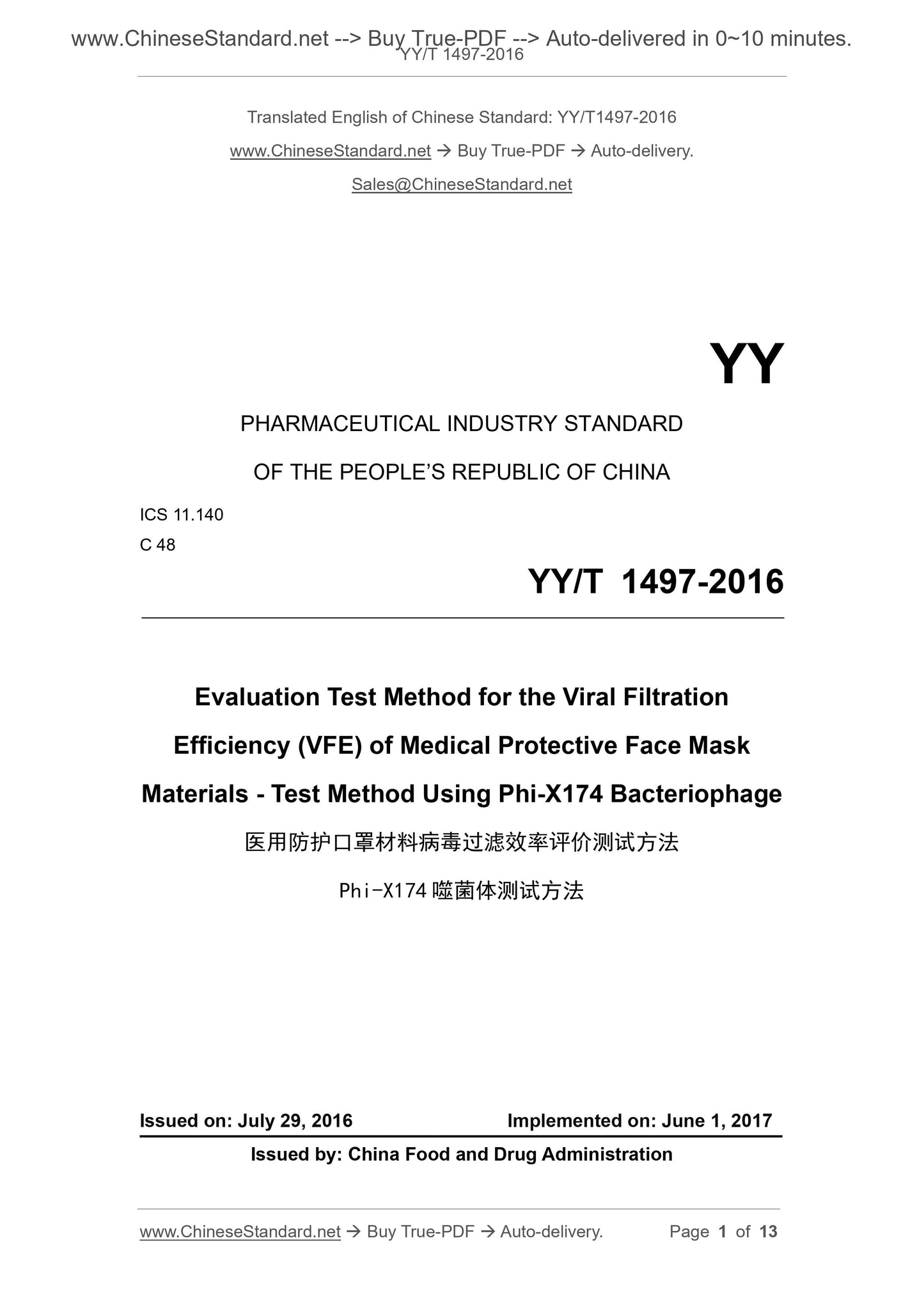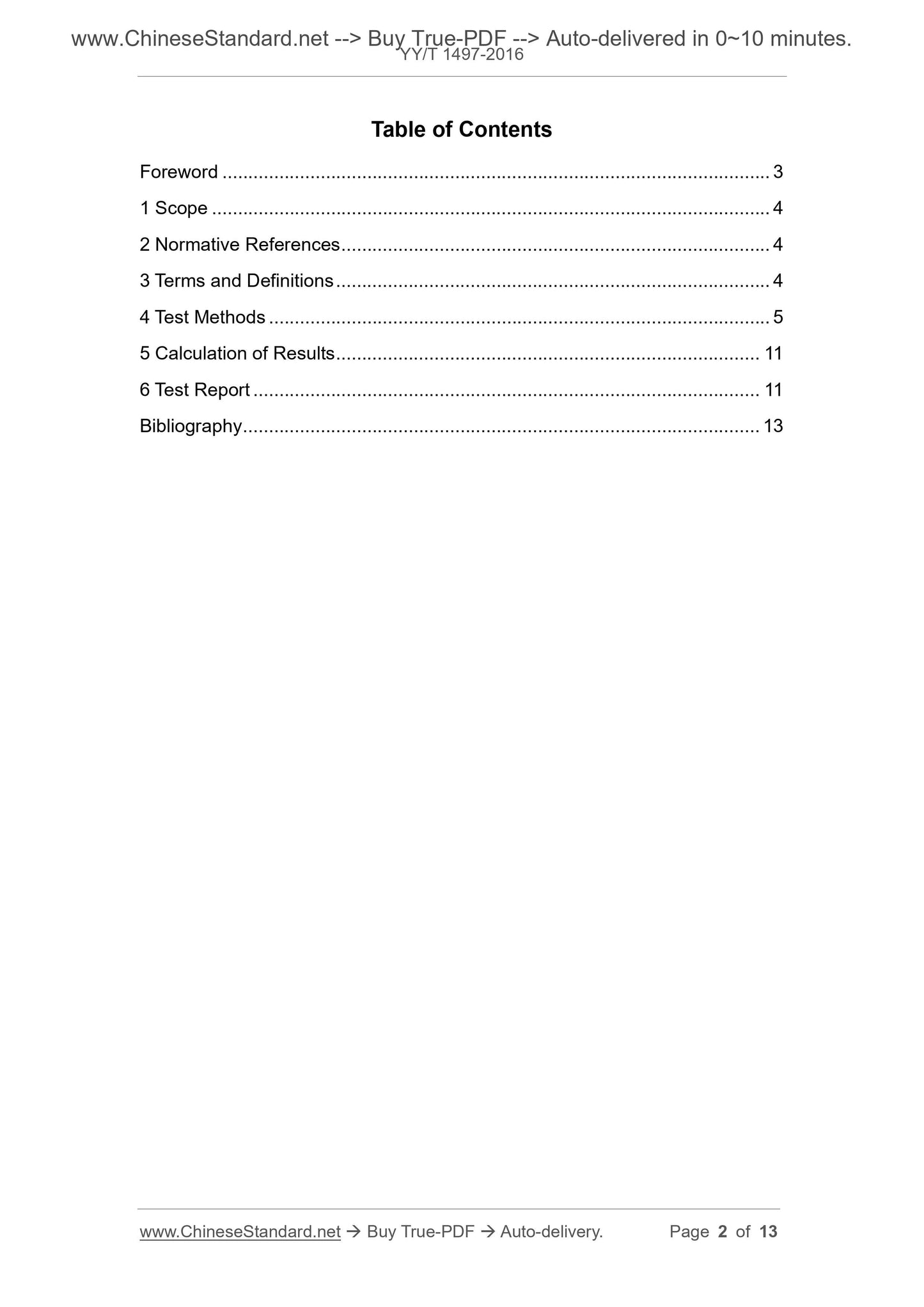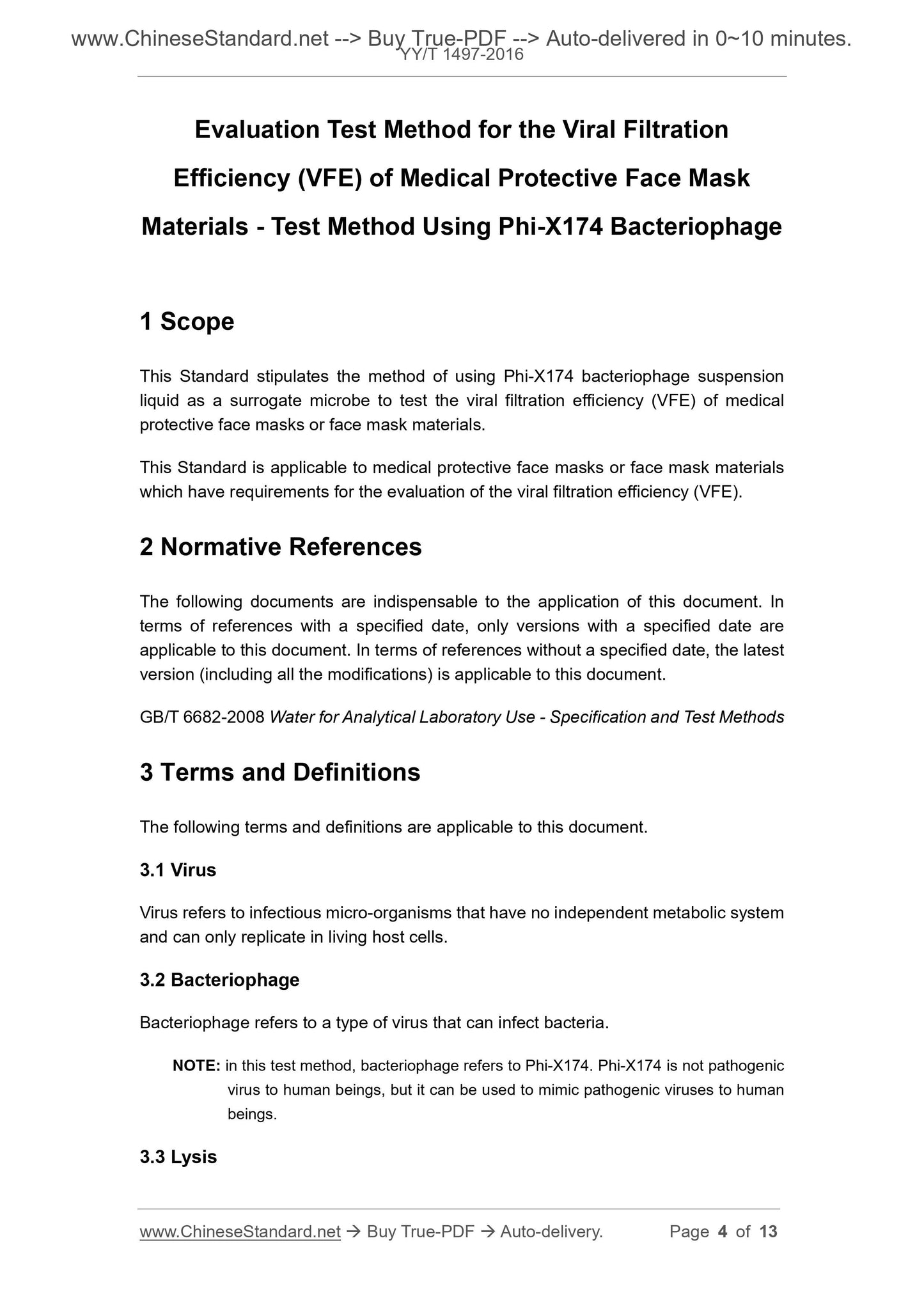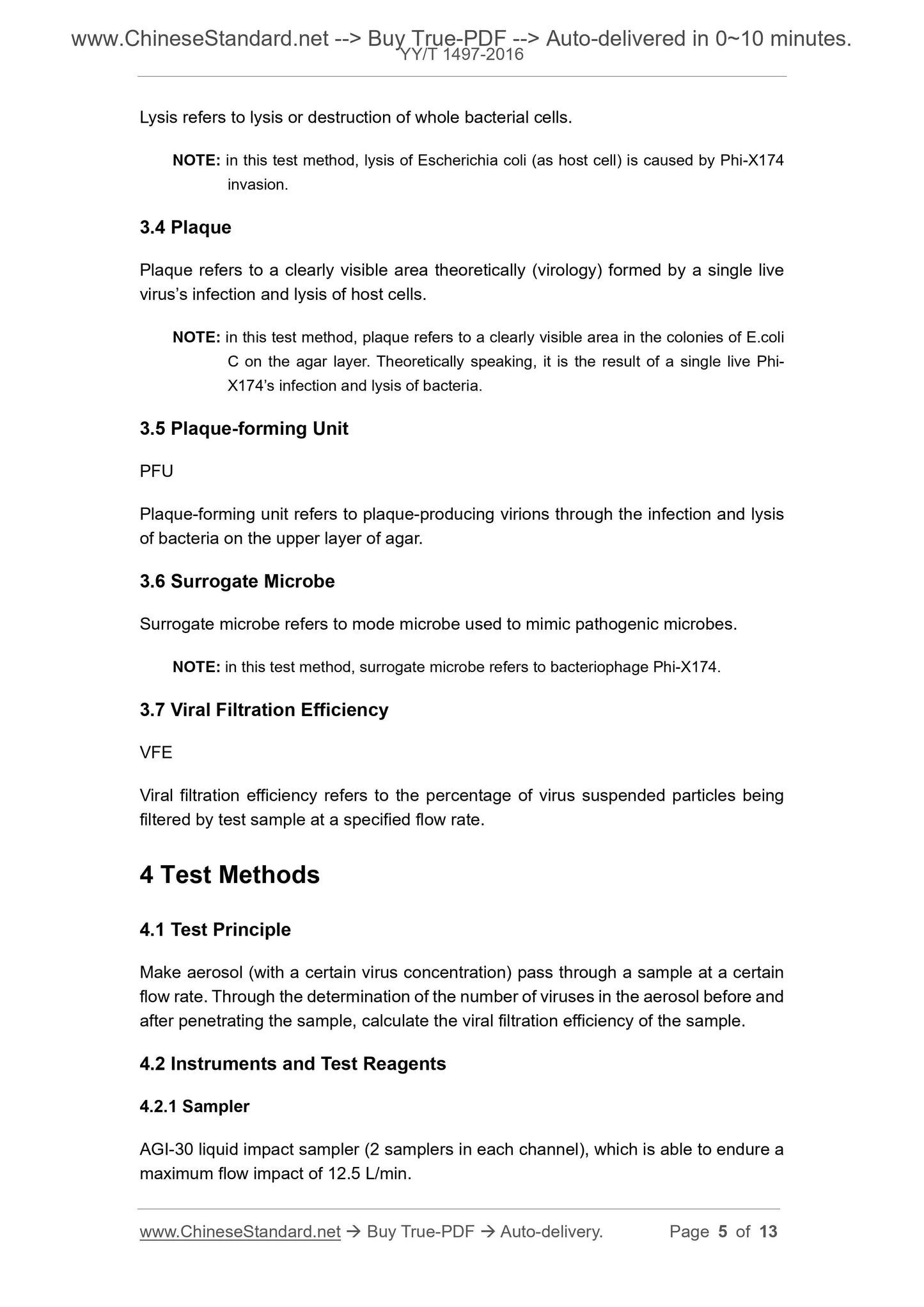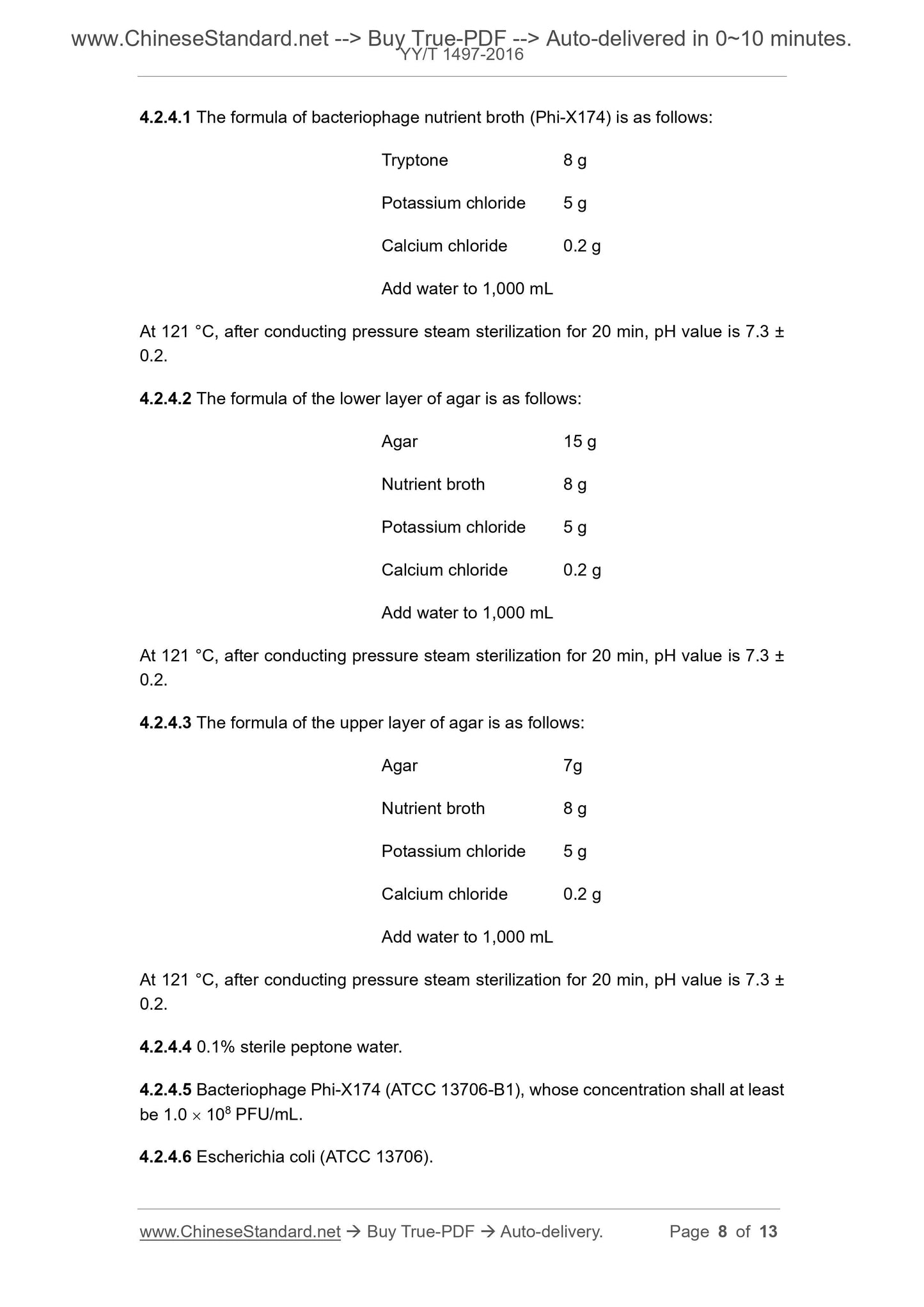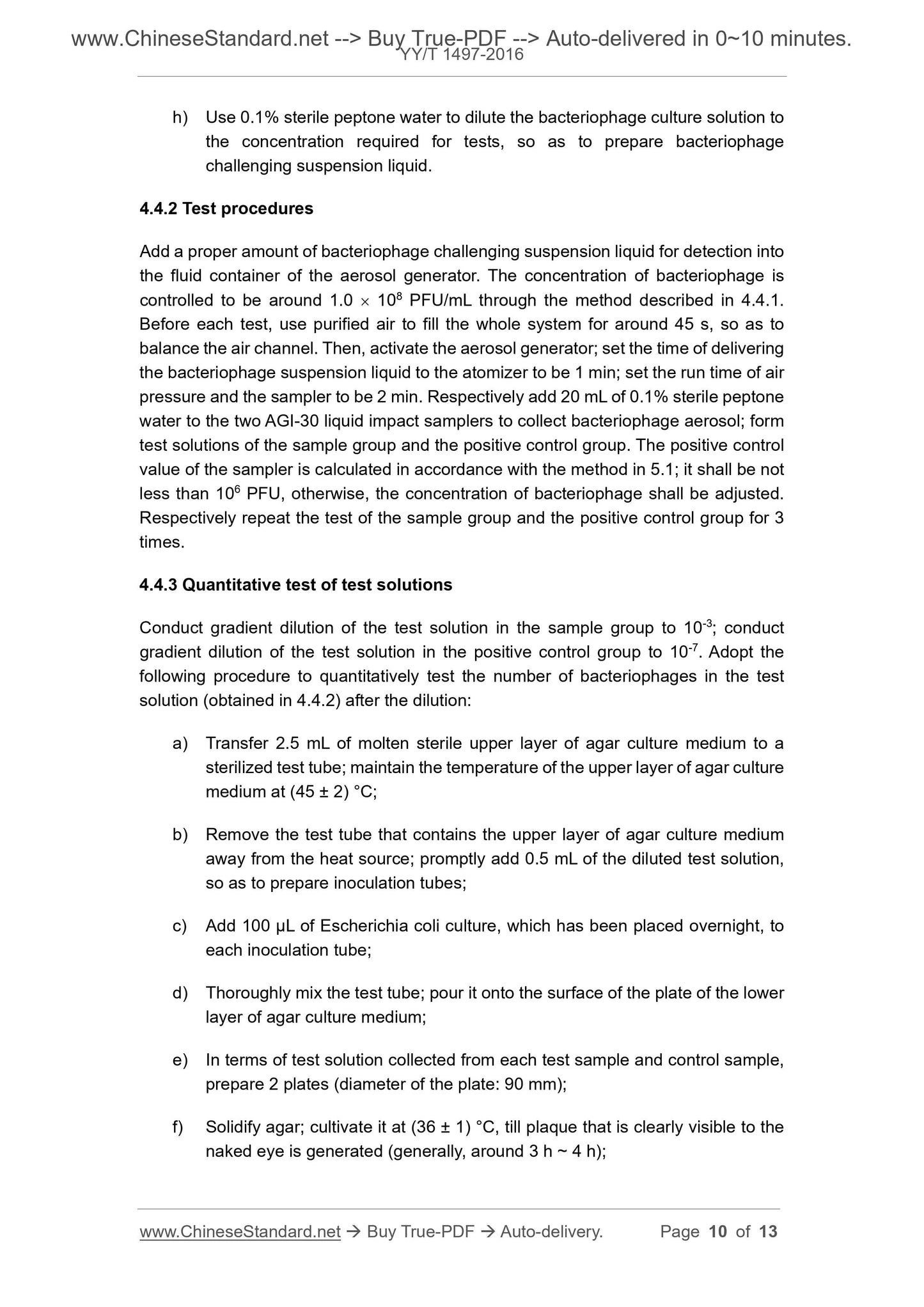1
/
of
6
PayPal, credit cards. Download editable-PDF & invoice in 1 second!
YY/T 1497-2016 English PDF (YYT1497-2016)
YY/T 1497-2016 English PDF (YYT1497-2016)
Regular price
$160.00 USD
Regular price
Sale price
$160.00 USD
Unit price
/
per
Shipping calculated at checkout.
Couldn't load pickup availability
Delivery: 3 seconds. Download true-PDF + Invoice.
Get QUOTATION in 1-minute: Click YY/T 1497-2016
Historical versions: YY/T 1497-2016
Preview True-PDF (Reload/Scroll if blank)
YY/T 1497-2016: Evaluation test method for the viral filtration efficiency(VFE)of medical protective face mask materials--Test method using Phi-X174 bacteriophage
YY/T 1497-2016
PHARMACEUTICAL INDUSTRY STANDARD
OF THE PEOPLE’S REPUBLIC OF CHINA
ICS 11.140
C 48
Evaluation Test Method for the Viral Filtration
Efficiency (VFE) of Medical Protective Face Mask
Materials - Test Method Using Phi-X174 Bacteriophage
ISSUED ON: JULY 29, 2016
IMPLEMENTED ON: JUNE 1, 2017
Issued by: China Food and Drug Administration
Table of Contents
Foreword ... 3
1 Scope ... 4
2 Normative References ... 4
3 Terms and Definitions ... 4
4 Test Methods ... 5
5 Calculation of Results ... 11
6 Test Report ... 11
Bibliography ... 13
Evaluation Test Method for the Viral Filtration
Efficiency (VFE) of Medical Protective Face Mask
Materials - Test Method Using Phi-X174 Bacteriophage
1 Scope
This Standard stipulates the method of using Phi-X174 bacteriophage suspension
liquid as a surrogate microbe to test the viral filtration efficiency (VFE) of medical
protective face masks or face mask materials.
This Standard is applicable to medical protective face masks or face mask materials
which have requirements for the evaluation of the viral filtration efficiency (VFE).
2 Normative References
The following documents are indispensable to the application of this document. In
terms of references with a specified date, only versions with a specified date are
applicable to this document. In terms of references without a specified date, the latest
version (including all the modifications) is applicable to this document.
GB/T 6682-2008 Water for Analytical Laboratory Use - Specification and Test Methods
3 Terms and Definitions
The following terms and definitions are applicable to this document.
3.1 Virus
Virus refers to infectious micro-organisms that have no independent metabolic system
and can only replicate in living host cells.
3.2 Bacteriophage
Bacteriophage refers to a type of virus that can infect bacteria.
NOTE: in this test method, bacteriophage refers to Phi-X174. Phi-X174 is not pathogenic
virus to human beings, but it can be used to mimic pathogenic viruses to human
beings.
3.3 Lysis
Lysis refers to lysis or destruction of whole bacterial cells.
NOTE: in this test method, lysis of Escherichia coli (as host cell) is caused by Phi-X174
invasion.
3.4 Plaque
Plaque refers to a clearly visible area theoretically (virology) formed by a single live
virus’s infection and lysis of host cells.
NOTE: in this test method, plaque refers to a clearly visible area in the colonies of E.coli
C on the agar layer. Theoretically speaking, it is the result of a single live Phi-
X174’s infection and lysis of bacteria.
3.5 Plaque-forming Unit
PFU
Plaque-forming unit refers to plaque-producing virions through the infection and lysis
of bacteria on the upper layer of agar.
3.6 Surrogate Microbe
Surrogate microbe refers to mode microbe used to mimic pathogenic microbes.
NOTE: in this test method, surrogate microbe refers to bacteriophage Phi-X174.
3.7 Viral Filtration Efficiency
VFE
Viral filtration efficiency refers to the percentage of virus suspended particles being
filtered by test sample at a specified flow rate.
4 Test Methods
4.1 Test Principle
Make aerosol (with a certain virus concentration) pass through a sample at a certain
flow rate. Through the determination of the number of viruses in the aerosol before and
after penetrating the sample, calculate the viral filtration efficiency of the sample.
4.2 Instruments and Test Reagents
4.2.1 Sampler
AGI-30 liquid impact sampler (2 samplers in each channel), which is able to endure a
maximum flow impact of 12.5 L/min.
4.2.4.1 The formula of bacteriophage nutrient broth (Phi-X174) is as follows:
Tryptone 8 g
Potassium chloride 5 g
Calcium chloride 0.2 g
Add water to 1,000 mL
At 121 °C, after conducting pressure steam sterilization for 20 min, pH value is 7.3 ±
0.2.
4.2.4.2 The formula of the lower layer of agar is as follows:
Agar 15 g
Nutrient broth 8 g
Potassium chloride 5 g
Calcium chloride 0.2 g
Add water to 1,000 mL
At 121 °C, after conducting pressure steam sterilization for 20 min, pH value is 7.3 ±
0.2.
4.2.4.3 The formula of the upper layer of agar is as follows:
Agar 7g
Nutrient broth 8 g
Potassium chloride 5 g
Calcium chloride 0.2 g
Add water to 1,000 mL
At 121 °C, after conducting pressure steam sterilization for 20 min, pH value is 7.3 ±
0.2.
4.2.4.4 0.1% sterile peptone water.
4.2.4.5 Bacteriophage Phi-X174 (ATCC 13706-B1), whose concentration shall at least
be 1.0 108 PFU/mL.
4.2.4.6 Escherichia coli (ATCC 13706).
h) Use 0.1% sterile peptone water to dilute the bacteriophage culture solution to
the concentration required for tests, so as to prepare bacteriophage
challenging suspension liquid.
4.4.2 Test procedures
Add a proper amount of bacteriophage challenging suspension liquid for detection into
the fluid container of the aerosol generator. The concentration of bacteriophage is
controlled to be around 1.0 108 PFU/mL through the method described in 4.4.1.
Before each test, use purified air to fill the whole system for around 45 s, so as to
balance the air channel. Then, activate the aerosol generator; set the time of delivering
the bacteriophage suspension liquid to the atomizer to be 1 min; set the run time of air
pressure and the sampler to be 2 min. Respectively add 20 mL of 0.1% sterile peptone
water to the two AGI-30 liquid impact samplers to collect bacteriophage aerosol; form
test solutions of the sample group and the positive control group. The positive control
value of the sampler is calculated in accordance with the method in 5.1; it shall be not
less than 106 PFU, otherwise, the concentration of bacteriophage shall be adjusted.
Respectively repeat the test of the sample group and the positive control group for 3
times.
4.4.3 Quantitative test of test solutions
Conduct gradient dilution of the test solution in the sample group to 10-3; conduct
gradient dilution of the test solution in the positive control group to 10-7. Adopt the
following procedure to quantitatively test the number of bacteriophages in the test
solution (obtained in 4.4.2) after the dilution:
a) Transfer 2.5 mL of molten sterile upper layer of agar culture medium to a
sterilized test tube; maintain the temperature of the upper layer of agar culture
medium at (45 ± 2) °C;
b) Remove the test tube that contains the upper layer of agar culture medium
away from the heat source; promptly add 0.5 mL of the diluted test solution,
so as to prepare inoculation tubes;
c) Add 100 μL of Escherichia coli culture, which has been placed overnight, to
each inoculation tube;
d) Thoroughly mix the test tube; pour it onto the surface of the plate of the lower
layer of agar culture medium;
e) In terms of test solution collected from each test sample and control sample,
prepare 2 plates (diameter of the plate: 90 mm);
f) Solidify agar; cultivate it at (36 ± 1) °C, till plaque that is clearly visible to the
naked eye is generated (generally, around 3 h ~ 4 h);
Get QUOTATION in 1-minute: Click YY/T 1497-2016
Historical versions: YY/T 1497-2016
Preview True-PDF (Reload/Scroll if blank)
YY/T 1497-2016: Evaluation test method for the viral filtration efficiency(VFE)of medical protective face mask materials--Test method using Phi-X174 bacteriophage
YY/T 1497-2016
PHARMACEUTICAL INDUSTRY STANDARD
OF THE PEOPLE’S REPUBLIC OF CHINA
ICS 11.140
C 48
Evaluation Test Method for the Viral Filtration
Efficiency (VFE) of Medical Protective Face Mask
Materials - Test Method Using Phi-X174 Bacteriophage
ISSUED ON: JULY 29, 2016
IMPLEMENTED ON: JUNE 1, 2017
Issued by: China Food and Drug Administration
Table of Contents
Foreword ... 3
1 Scope ... 4
2 Normative References ... 4
3 Terms and Definitions ... 4
4 Test Methods ... 5
5 Calculation of Results ... 11
6 Test Report ... 11
Bibliography ... 13
Evaluation Test Method for the Viral Filtration
Efficiency (VFE) of Medical Protective Face Mask
Materials - Test Method Using Phi-X174 Bacteriophage
1 Scope
This Standard stipulates the method of using Phi-X174 bacteriophage suspension
liquid as a surrogate microbe to test the viral filtration efficiency (VFE) of medical
protective face masks or face mask materials.
This Standard is applicable to medical protective face masks or face mask materials
which have requirements for the evaluation of the viral filtration efficiency (VFE).
2 Normative References
The following documents are indispensable to the application of this document. In
terms of references with a specified date, only versions with a specified date are
applicable to this document. In terms of references without a specified date, the latest
version (including all the modifications) is applicable to this document.
GB/T 6682-2008 Water for Analytical Laboratory Use - Specification and Test Methods
3 Terms and Definitions
The following terms and definitions are applicable to this document.
3.1 Virus
Virus refers to infectious micro-organisms that have no independent metabolic system
and can only replicate in living host cells.
3.2 Bacteriophage
Bacteriophage refers to a type of virus that can infect bacteria.
NOTE: in this test method, bacteriophage refers to Phi-X174. Phi-X174 is not pathogenic
virus to human beings, but it can be used to mimic pathogenic viruses to human
beings.
3.3 Lysis
Lysis refers to lysis or destruction of whole bacterial cells.
NOTE: in this test method, lysis of Escherichia coli (as host cell) is caused by Phi-X174
invasion.
3.4 Plaque
Plaque refers to a clearly visible area theoretically (virology) formed by a single live
virus’s infection and lysis of host cells.
NOTE: in this test method, plaque refers to a clearly visible area in the colonies of E.coli
C on the agar layer. Theoretically speaking, it is the result of a single live Phi-
X174’s infection and lysis of bacteria.
3.5 Plaque-forming Unit
PFU
Plaque-forming unit refers to plaque-producing virions through the infection and lysis
of bacteria on the upper layer of agar.
3.6 Surrogate Microbe
Surrogate microbe refers to mode microbe used to mimic pathogenic microbes.
NOTE: in this test method, surrogate microbe refers to bacteriophage Phi-X174.
3.7 Viral Filtration Efficiency
VFE
Viral filtration efficiency refers to the percentage of virus suspended particles being
filtered by test sample at a specified flow rate.
4 Test Methods
4.1 Test Principle
Make aerosol (with a certain virus concentration) pass through a sample at a certain
flow rate. Through the determination of the number of viruses in the aerosol before and
after penetrating the sample, calculate the viral filtration efficiency of the sample.
4.2 Instruments and Test Reagents
4.2.1 Sampler
AGI-30 liquid impact sampler (2 samplers in each channel), which is able to endure a
maximum flow impact of 12.5 L/min.
4.2.4.1 The formula of bacteriophage nutrient broth (Phi-X174) is as follows:
Tryptone 8 g
Potassium chloride 5 g
Calcium chloride 0.2 g
Add water to 1,000 mL
At 121 °C, after conducting pressure steam sterilization for 20 min, pH value is 7.3 ±
0.2.
4.2.4.2 The formula of the lower layer of agar is as follows:
Agar 15 g
Nutrient broth 8 g
Potassium chloride 5 g
Calcium chloride 0.2 g
Add water to 1,000 mL
At 121 °C, after conducting pressure steam sterilization for 20 min, pH value is 7.3 ±
0.2.
4.2.4.3 The formula of the upper layer of agar is as follows:
Agar 7g
Nutrient broth 8 g
Potassium chloride 5 g
Calcium chloride 0.2 g
Add water to 1,000 mL
At 121 °C, after conducting pressure steam sterilization for 20 min, pH value is 7.3 ±
0.2.
4.2.4.4 0.1% sterile peptone water.
4.2.4.5 Bacteriophage Phi-X174 (ATCC 13706-B1), whose concentration shall at least
be 1.0 108 PFU/mL.
4.2.4.6 Escherichia coli (ATCC 13706).
h) Use 0.1% sterile peptone water to dilute the bacteriophage culture solution to
the concentration required for tests, so as to prepare bacteriophage
challenging suspension liquid.
4.4.2 Test procedures
Add a proper amount of bacteriophage challenging suspension liquid for detection into
the fluid container of the aerosol generator. The concentration of bacteriophage is
controlled to be around 1.0 108 PFU/mL through the method described in 4.4.1.
Before each test, use purified air to fill the whole system for around 45 s, so as to
balance the air channel. Then, activate the aerosol generator; set the time of delivering
the bacteriophage suspension liquid to the atomizer to be 1 min; set the run time of air
pressure and the sampler to be 2 min. Respectively add 20 mL of 0.1% sterile peptone
water to the two AGI-30 liquid impact samplers to collect bacteriophage aerosol; form
test solutions of the sample group and the positive control group. The positive control
value of the sampler is calculated in accordance with the method in 5.1; it shall be not
less than 106 PFU, otherwise, the concentration of bacteriophage shall be adjusted.
Respectively repeat the test of the sample group and the positive control group for 3
times.
4.4.3 Quantitative test of test solutions
Conduct gradient dilution of the test solution in the sample group to 10-3; conduct
gradient dilution of the test solution in the positive control group to 10-7. Adopt the
following procedure to quantitatively test the number of bacteriophages in the test
solution (obtained in 4.4.2) after the dilution:
a) Transfer 2.5 mL of molten sterile upper layer of agar culture medium to a
sterilized test tube; maintain the temperature of the upper layer of agar culture
medium at (45 ± 2) °C;
b) Remove the test tube that contains the upper layer of agar culture medium
away from the heat source; promptly add 0.5 mL of the diluted test solution,
so as to prepare inoculation tubes;
c) Add 100 μL of Escherichia coli culture, which has been placed overnight, to
each inoculation tube;
d) Thoroughly mix the test tube; pour it onto the surface of the plate of the lower
layer of agar culture medium;
e) In terms of test solution collected from each test sample and control sample,
prepare 2 plates (diameter of the plate: 90 mm);
f) Solidify agar; cultivate it at (36 ± 1) °C, till plaque that is clearly visible to the
naked eye is generated (generally, around 3 h ~ 4 h);
Share
